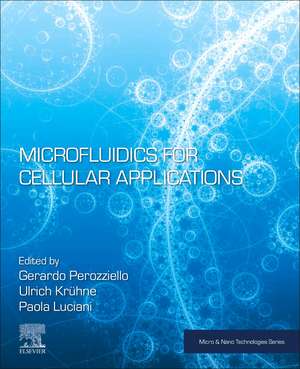Microfluidics for Cellular Applications: Micro and Nano Technologies
Editat de Gerardo Perozziello, Ulrich Kruhne, Paola Lucianien Limba Engleză Paperback – 19 apr 2023
- Outlines the major applications of microfluidic devices in medicine and biotechnology
- Assesses the major challenges of using microfluidic devices in terms of complexity of the control set-up, ease of use, integration capability, automation level, analysis throughput, content and costs
- Describes the major fabrication techniques for assembling effective microfluidic devices for bioapplications
Din seria Micro and Nano Technologies
- 20%
 Preț: 768.40 lei
Preț: 768.40 lei - 18%
 Preț: 2031.79 lei
Preț: 2031.79 lei - 9%
 Preț: 1043.14 lei
Preț: 1043.14 lei - 9%
 Preț: 987.08 lei
Preț: 987.08 lei -
 Preț: 550.23 lei
Preț: 550.23 lei - 24%
 Preț: 1048.26 lei
Preț: 1048.26 lei - 23%
 Preț: 1100.40 lei
Preț: 1100.40 lei - 28%
 Preț: 738.06 lei
Preț: 738.06 lei - 23%
 Preț: 692.90 lei
Preț: 692.90 lei - 28%
 Preț: 571.91 lei
Preț: 571.91 lei - 9%
 Preț: 733.82 lei
Preț: 733.82 lei - 23%
 Preț: 734.77 lei
Preț: 734.77 lei - 28%
 Preț: 811.47 lei
Preț: 811.47 lei - 16%
 Preț: 766.36 lei
Preț: 766.36 lei - 28%
 Preț: 934.58 lei
Preț: 934.58 lei - 32%
 Preț: 528.10 lei
Preț: 528.10 lei - 23%
 Preț: 810.11 lei
Preț: 810.11 lei - 23%
 Preț: 603.19 lei
Preț: 603.19 lei - 9%
 Preț: 571.98 lei
Preț: 571.98 lei - 28%
 Preț: 825.39 lei
Preț: 825.39 lei -
 Preț: 222.86 lei
Preț: 222.86 lei - 16%
 Preț: 290.93 lei
Preț: 290.93 lei - 19%
 Preț: 659.03 lei
Preț: 659.03 lei - 18%
 Preț: 653.54 lei
Preț: 653.54 lei - 23%
 Preț: 746.61 lei
Preț: 746.61 lei - 9%
 Preț: 1016.51 lei
Preț: 1016.51 lei - 9%
 Preț: 736.59 lei
Preț: 736.59 lei - 29%
 Preț: 803.90 lei
Preț: 803.90 lei - 9%
 Preț: 963.06 lei
Preț: 963.06 lei - 28%
 Preț: 644.55 lei
Preț: 644.55 lei - 23%
 Preț: 813.30 lei
Preț: 813.30 lei - 23%
 Preț: 608.83 lei
Preț: 608.83 lei - 9%
 Preț: 683.99 lei
Preț: 683.99 lei - 9%
 Preț: 792.39 lei
Preț: 792.39 lei - 23%
 Preț: 732.00 lei
Preț: 732.00 lei - 23%
 Preț: 909.30 lei
Preț: 909.30 lei - 28%
 Preț: 698.33 lei
Preț: 698.33 lei - 29%
 Preț: 989.78 lei
Preț: 989.78 lei - 28%
 Preț: 737.80 lei
Preț: 737.80 lei - 9%
 Preț: 848.26 lei
Preț: 848.26 lei - 23%
 Preț: 937.71 lei
Preț: 937.71 lei - 23%
 Preț: 692.32 lei
Preț: 692.32 lei - 24%
 Preț: 869.31 lei
Preț: 869.31 lei - 23%
 Preț: 609.24 lei
Preț: 609.24 lei - 18%
 Preț: 222.37 lei
Preț: 222.37 lei - 28%
 Preț: 816.40 lei
Preț: 816.40 lei - 9%
 Preț: 811.32 lei
Preț: 811.32 lei - 21%
 Preț: 292.28 lei
Preț: 292.28 lei - 9%
 Preț: 807.78 lei
Preț: 807.78 lei - 5%
 Preț: 637.68 lei
Preț: 637.68 lei
Preț: 989.44 lei
Preț vechi: 1295.30 lei
-24% Nou
Puncte Express: 1484
Preț estimativ în valută:
189.32€ • 198.20$ • 156.66£
189.32€ • 198.20$ • 156.66£
Carte tipărită la comandă
Livrare economică 29 martie-12 aprilie
Preluare comenzi: 021 569.72.76
Specificații
ISBN-13: 9780128224823
ISBN-10: 0128224827
Pagini: 432
Dimensiuni: 191 x 235 mm
Greutate: 0.74 kg
Editura: ELSEVIER SCIENCE
Seria Micro and Nano Technologies
ISBN-10: 0128224827
Pagini: 432
Dimensiuni: 191 x 235 mm
Greutate: 0.74 kg
Editura: ELSEVIER SCIENCE
Seria Micro and Nano Technologies
Cuprins
1. Cell microenvironment
2. Operations on cells (conventional procedures and physical principles) related to specific purposes and applications 3. Microfluidic devices in general
4. CFD simulations (also describing the help it gives in relation to filling the gap)
5. Materials
6. Surface properties and functionalization
7. Fabrication technologies
8. Sensor technologies
2. Operations on cells (conventional procedures and physical principles) related to specific purposes and applications 3. Microfluidic devices in general
4. CFD simulations (also describing the help it gives in relation to filling the gap)
5. Materials
6. Surface properties and functionalization
7. Fabrication technologies
8. Sensor technologies
